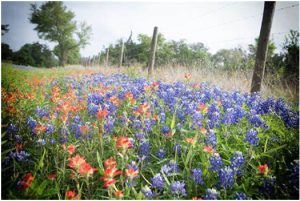Emmy Ulmschneider
Master Gardeners
Texas is known for its iconic spring wildflowers. But to have wildflowers in the spring you need to start in the fall and hope for rain at the right time! Right now, if you can walk in a native wild area, the wildflowers are amazing. Emmy reports that at the Windlands Natural Area she found 10 species of blooming wildflowers. With all the rain we have had, they are getting a headstart on spring! Emmy also bluebonnets, golden poppies, and larkspur popping up all over.
Late fall is the ideal time to plant wildflowers in West Texas. Try to shoot for Oct. 15 – Oct. 31 each year. This gives you plenty of time to research, order, and get them delivered by planting time.
Here is the short take on how to sow them:
Use a rake to loosen the top few inches of soil and even it out. This should be easy right now since we have been blessed with rain. Apply the seed evenly and then rake again putting about 1/8” of soil over the seeds. Water occasionally until the seeds germinate. Fertilize with a seed starter fertilizer for better success in your wildflower garden.
For more detailed information, checkout our blog article Sowing Native Seeds from 10/10/2021 at tinyurl.com/2p8xe47e.
So, where do you get seeds, and how do you know they are suited for our area? Most national seed companies, as well as Texas seed companies, offer seed packets and mixes specifically suited to West Texas. Check out what is available, and you might consider trying a single species seed packet instead of a wildflower mix. Look at the information on the seed packet or online. Some seed companies even have pictures of the seed leaves or cotyledons so that you can actually tell what has germinated before the true leaves arrive.

You get the most bang for your buck by planting native seeds instead of alien seeds. Another good source of seeds comes from people who save seeds from the previous year. If you have a native garden in your area, you might ask the gardener if they have seeds to share.
Every year, people ask why their bluebonnet seeds did not germinate. Bluebonnets are legumes and have a mutualistic relationship with rhizobium bacteria in the soil. These bacteria, form nodules on the roots where they convert nitrogen in the air to a plant useable form. Local soils have local bacteria. Bluebonnets bloom better in the presence of local rhizobium bacteria. To increase the germination rate, you can buy seeds which are pre-inoculated with rhizobium or increase the number of seeds that you plant. So, go online, visit a store, or talk to a gardener for colors and shapes to bring your garden to life and welcome in spring!
For more information, call the AgriLife office at 498-4071 in Odessa or at 686-4700 in Midland or visit aggie-horticulture.tamu.edu or westtexasgardening.org.




